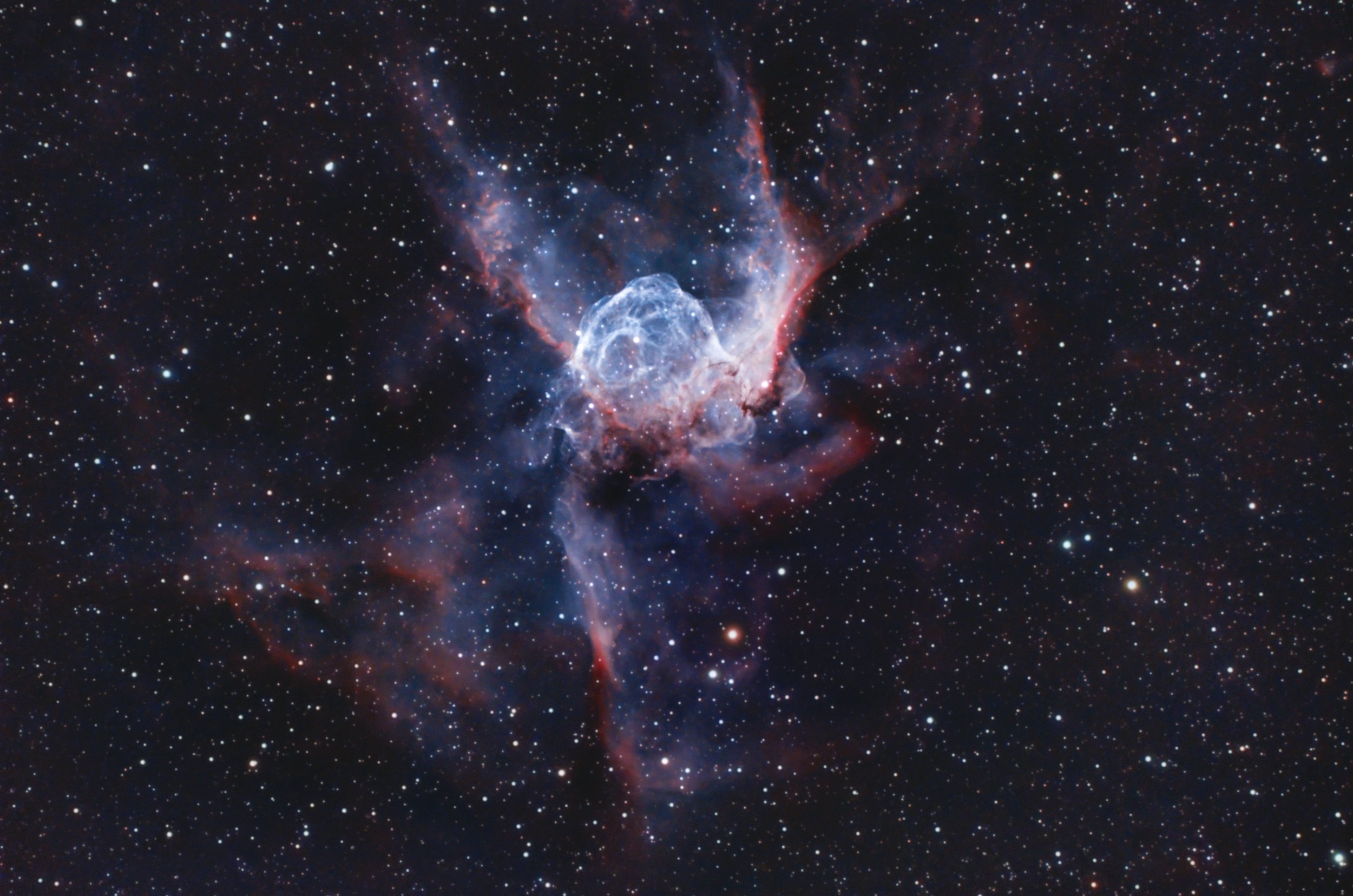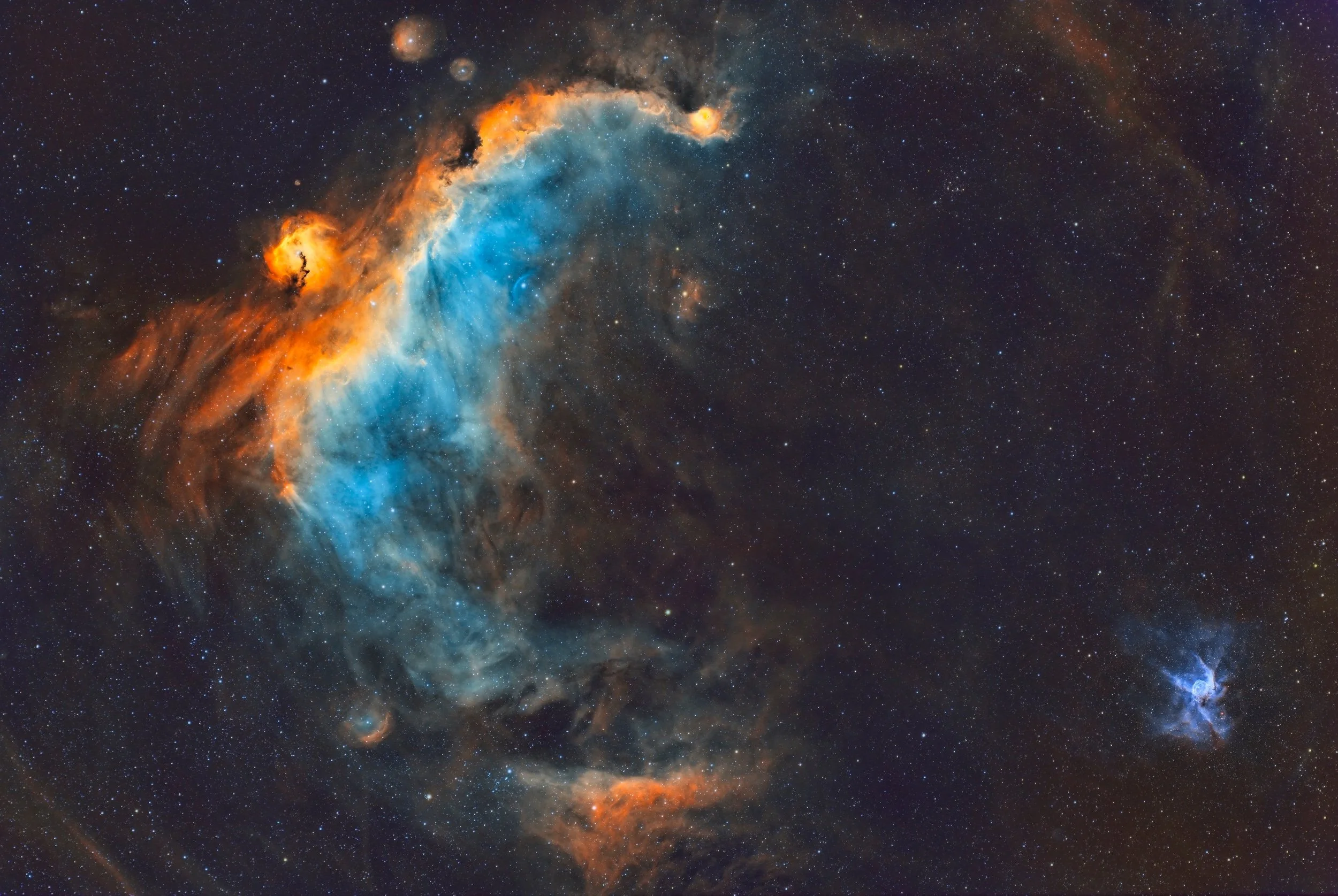
AAPOD2 Image Archives
Thor’s Helmet – A Wolf-Rayet Bubble in Canis Major
Thor’s Helmet (NGC 2359) is a dramatic emission nebula located in the constellation Canis Major, roughly 12,000 light-years from Earth. Its helmet-like shape, complete with sweeping arcs and wing-like extensions, is sculpted by intense stellar winds from a rare, massive Wolf-Rayet star at its center. Though often mistaken for a planetary nebula, it is more akin to structures like the Crescent or Bubble Nebula—formed not by a dying sun-like star, but by a massive star in an extremely active stage of its life.
Spanning about 30 light-years across, this stellar bubble glows in vivid hues of ionized gas, most prominently in hydrogen, oxygen, and sulfur emission lines. Its intricate form and turbulent textures make it a favorite among astrophotographers and a vivid example of the power and beauty of massive stars reshaping their surroundings.
Ngc2359 Thor's Helmet
NGC 2359, famously known as Thor’s Helmet, is a striking emission nebula located 15,000 light-years away in the constellation Canis Major. This cosmic structure, shaped by intense stellar winds, resembles the helmet of the Norse god Thor, complete with sweeping, wing-like extensions of glowing gas.
At its core lies a Wolf-Rayet star (WR7)—an exceptionally hot and massive star in a late stage of its evolution. This star is shedding its outer layers at speeds exceeding 2,000 km/s, creating powerful shockwaves that shape the nebula’s complex arcs and filaments.
Captured in the SHO (Hubble Palette) narrowband, this image reveals the nebula’s intricate structure and ionization zones:
Sulfur-II (SII) in deep red, highlighting cooler, dense regions of gas.
Hydrogen-alpha (Ha) in golden yellow, mapping the expansive ionized hydrogen clouds.
Oxygen-III (OIII) in electric blues, tracing the high-energy zones near the Wolf-Rayet star.
Spanning 30 light-years across, Thor’s Helmet is not only a spectacular sight but also a pre-supernova candidate, meaning WR7 will eventually explode in a supernova, enriching the interstellar medium with heavy elements.
With over 18 hours of exposure time, this meticulously processed image unveils the nebula’s intricate details and dynamic interplay of stellar forces, making it a testament to the power and beauty of our universe.
Thor's Helmet - NGC 2359
Image Description and Details :
Thor's Helmet - NGC 2359 Thor's Helmet, an emission nebula ~11,960 light years away, is in the constellation Canis Major. The central star is the Wolf-Rayet star WR7, a star thought to be in a brief pre-supernova stage of evolution. Acquisition: Location: Queen Creek, AZ Bortle 7 Date: 2022-02-26 - 2022-03-11 Lights (Dithered, Cooled 0°C, Gain 100): 199 x 180s Darks: 25 Flats: 25 Dark Flats: 25Hardware: Camera: ZWO ASI 2600MC PRO Scope: Celestron EdgeHD 11" Focal Reducer: Celestron 0.7x Focuser: Prodigy Microfocuser Guide Camera: Unguided Guide Scope: Unguided Mount: GM2000 HPS II Filter: Optolong L-EnhanceSoftware: SGP Pixinsight PhotoshopProcessing: Stacked in Pixinsight (WBPP, SubframeSelector, DrizzleIntegration) Pixinsight (DCrop, ABE, PhotometricCC, EZDenoise, EZSoftStretch, EZStarReduction, StarNet2)) Gradient removal using GradientXterminator Camera Raw Filter in Photoshop AstroFlat Pro Color/Levels Adjustments
Copyright: James Hawks
The Giant Vs. The Mighty
Image Description and Details :
This shows the huge Seagull Nebula, and the very small (in comparison) but bright Thor’s Helmet Nebula, in narrowband.
This is an image 2 years in the making. I spent 10 full nights on imaging the Seagull Nebula wide field, as I also wanted to include Thor’s Helmet in the frame. I then added an extra 2 nights worth of data using a larger telescope on Thor’s Helmet only. This allowed me to get a nicer view on that target. All the data acquired was by myself with my own gear.
The Seagull Nebula is known as IC 2177. It is a large nebula that can be found 3,650 light-years away in Monoceros. It is a great target for both broadband and narrowband imaging, and is very close to the much smaller Thor's Helmet Nebula.
If you look closely near the Oxygen gases of the Seagull Nebula, you should be able to spot a bright star with a strange arc-shaped line of gas just above it. This is commonly known as the "Bow shockwave" in IC 2177. It is believed to come from the interaction between the interstellar dust within the nebula, high radiation winds, and gas expelling from the double star system "FN CMa”. The exact origin is still not very clear, but we might learn more about it in the years to come!
Thor’s Helmet is known as NGC 2359. It is a cloud of interstellar gas, although very faint, the colors in the gases really pop when taking long exposure shots with any camera.
This beautiful deep-sky object gets its glow from WR7, a massive Wolf-Rayet star that will soon turn into a supernova.
This is a total of 61 hours of exposure, a record for me as my longest acquisition so far was 48 hours. I captured 99% of the data from the city, Bortle 9. I captured a little bit of the data (half a night) from a Bortle 4 spot in the desert for the OIII in Thor’s Helmet.
Acquisition Info:
Target: The Seagull Nebula and Thor Nebula
Imaged from: Las Vegas Bortle 9 + Nevada Desert Bortle 4 | January/February 2022
Camera: QHY600M
Filters: S+H+O for Seagull wide field, H+O for Thor’s Helmet
Telescope: Meade 70mm APO for Seagull wide field, SVX130 for Thor’s Helmet close up
Time per frame: 600sec
Time total: 61 hours total. 50 hours for the overall image wide field + an additional 11 hours for Thor’s Helmet close up.
Copyright: Antoine & Dalia Grelin
Thor's Helmet
Image Description and Details :
Popularly called Thor's Helmet, NGC 2359 is a hat-shaped cosmic cloud with wing-like appendages. Heroically sized even for a Norse god, Thor's Helmet is about 30 light-years across. In fact, the cosmic head-covering is more like an interstellar bubble, blown with a fast wind from the bright, massive star near the bubble's center. Known as a Wolf-Rayet star, the central star is an extremely hot giant thought to be in a brief, pre-supernova stage of evolution. NGC 2359 is located about 15,000 light-years away toward the constellation of the Great Overdog. This remarkably sharp image is a mixed cocktail of data from broadband and narrowband filters, capturing not only natural looking stars but details of the nebula's filamentary structures. The star in the center of Thor's Helmet is expected to explode in a spectacular supernova sometime within the next few thousand years.
Location/Date – El Sauce, Chile
Imaging System – Planewave CDK17, FLI ML16803, Chroma HaO3RGB filters, 10 Micron GM3000
Exposure – HORGB, 27.5 hours
Copyright: Good Astronomy
Thor’s Helmet
Thor’s Helmet (NGC 2539, Sh2-298, Gum 4) is an emission nebula in Canis Major. The powerful Wolf-Rayet star WR7 near the centre of the nebula is causing the gases to glow. That star is thought to be in a brief pre-supernova stage, and could explode in the cosmically-not-too-distant future. This object is thought to be similar to the Bubble Nebula, but the energy from WR7 has blown the gas in Thor’s Helmet into more complex shapes. Thor’s Helmet also contains much more oxygen structures than the Bubble Nebula. Oxygen gives the teal-coloured structure; hydrogen provides the reds. This nebula contains hundreds of solar masses of ionized gases (the gases that are glowing), along with hundreds of thousands of solar masses of unionized material. The age of the nebula is uncertain, with estimates ranging from 78,500 to 236,000.
This data used to create this image was acquired from Yass, New South Wales, Australia by my friend, expert astrophotographer Martin Pugh. Thank you Martin!
Tekkies:
SBIG STXL-11002 camera, Astrodon Ha, O3, R, G and B filters, Planewave 17″ CDK, Paramount ME. Equipment control with the SkyX, scripted with CCDAutopilot. All pre-processing and processing in PixInsight, except that master calibration frames were made using CCDStack. Data Acquired by Martin Pugh, from Yass, NSW, Australia.
3x10m R and B, 4x10m B, 18x20m Ha and 13x30m O3 unbinned frames (total=14hr10m).
Image scale is 0.63 arcsec per pixel for this camera / telescope combination.
Copyright: Ron Brecher







